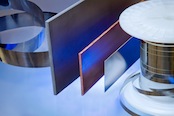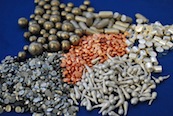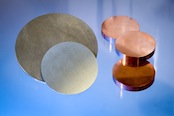Niobium Oxide
MATERIAL SAFETY DATA SHEET
I. PRODUCT IDENTIFICATION
Manufacturer/Supplier:
ESPI Metals
1050 Benson Way, Ashland, OR 97520
Toll Free (800) 638-2581 * Fax (541) 488-8313
E-Mail: This email address is being protected from spambots. You need JavaScript enabled to view it.
Product Name: Niobium Oxide
Formula: Nb2O5
CAS Number: 1313-96-8
Synonym: Niobium Pentoxide, Columbium Pentoxide
II. HAZARDOUS INGREDIENTS
Hazardous Components: Niobium Oxide
Percent (%): 0-100
OSHA/PEL: N/E
ACGIH/TLV: N/E
HMIS Ratings:
Health: 1
Flammability: 0
Reactivity: 0
III. PHYSICAL DATA
Boiling Point: N/A
Melting Point: 1520 oC
Specific Gravity: 4.47 g/cc
Solubility in H2O: Insoluble
Appearance and Odor: White crystals or powder, no odor
IV. FIRE AND EXPLOSION HAZARDS DATA
Flash Point: N/A
Autoignition Temperature: N/A
Flammable Limits: Upper: N/A Lower: N/A
Extinguishing Media: Use suitable extinguishing media for surrounding material and type of fire.
Special Fire Fighting Procedures: Firefighters must wear full face, self-contained breathing apparatus and full protective clothing to prevent contact with skin and eyes. Fumes from fire are hazardous. Isolate runoff to prevent environmental pollution.
Unusual Fire & Explosion Hazard: Niobium oxide may emit toxic fumes if involved in a fire.
V. HEALTH HAZARD INFORMATION
To the best of our knowledge the chemical, physical and toxicological properties of niobium pentoxide have not been thoroughly investigated and recorded.
Niobium compounds have caused liver damage in animal studies. Niobium metal has caused kidney damage in experimental animals and fibrogenic effects on the lungs of experimental animals.
Acute Effects:
Inhalation: May cause irritation to the nose and throat.
Ingestion: No acute health effects recorded.
Skin: May cause irritation.
Eye: May cause irritation.
Chronic Effects:
Inhalation: May cause kidney damage and fibrogenic effects on the lungs.
Ingestion: No chronic health effects recorded.
Skin: No chronic health effects recorded.
Eye: No chronic health effects recorded.
Target Organs: May affect the kidneys and lungs.
Medical Conditions Generally Aggravated by Exposure: Pre-existing respiratory disorders.
Carcinogenicity: NTP: No IARC: No OSHA: No
EMERGENCY AND FIRST AID PROCEDURES:
INHALATION: Remove to fresh air, keep warm and quiet, give oxygen if breathing is difficult and seek medical attention.
INGESTION: Give 1-2 glasses of milk or water and induce vomiting, seek medical attention. Never induce vomiting or give anything by mouth to an unconscious person.
SKIN: Remove contaminated clothing from affected area, brush material off skin, wash with soap or mild detergent and large amounts of water. Seek medical attention, if needed.
EYES: Flush eyes immediately with large amounts of water, lifting upper and lower lids. Seek medical attention if symptoms persist.
VI. REACTIVITY DATA
Stability: Stable
Conditions to Avoid: None
Incompatibility (Material to Avoid): Strong acids and bases.
Hazardous Decomposition Products: None known
Hazardous Polymerization: Will not occur
VII. SPILL OR LEAK PROCEDURES
Steps to Be Taken in Case Material Is Released or Spilled: Wear appropriate respiratory and protective equipment specified in section VIII. Isolate spill area, provide ventilation and extinguish sources of ignition. Vacuum up spill using a high efficiency particulate absolute (HEPA) air filter and place in a closed container for proper disposal. Take care not to raise dust. Use non-sparking tools.
Waste Disposal Method: In accordance with Local, State and Federal Waste Disposal Regulations.
VIII. SPECIAL PROTECTION INFORMATION
Respiratory Protection: Wear appropriate NIOSH-approved respirator.
Ventilation: Use local exhaust to maintain concentration at low exposure limits. General exhaust is recommended.
Protective Gloves: Rubber gloves
Eye Protection: Safety goggles
Other Protective Clothing or Equipment: Wear appropriate chemical resistant clothing.
IX. SPECIAL PRECAUTIONS
Precautions to Be Taken in Handling and Storage: Store in a cool, dry place in tightly sealed containers. Ensure good ventilation at the workplace. Open and handle container with care.
Work Practices: Implement engineering and work practice controls to reduce and maintain concentration of exposure at low levels. Use good housekeeping and sanitation practices. Do not use tobacco or food in work area. Wash thoroughly before eating and smoking. Do not blow dust off clothing or skin with compressed air. Maintain eyewash capable of sustained flushing, safety drench shower and facilities for washing.
TSCA Listed: Yes
DOT Regulations:
Hazard Class: None
The above information is believed to be correct, but does not purport to be all inclusive and shall be used only as a guide. ESPI shall not be held liable for any damage resulting from handling or from contact with the above product.
Issued by: S. Dierks
Revised/Verified: January 2010

 ALLOYS
ALLOYS 





